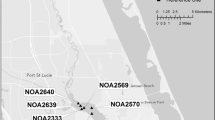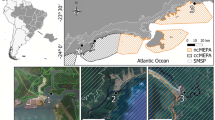Abstract
This study was conducted to support a Natural Resource Damage Assessment and Restoration project associated with the Ashtabula River in Ohio. The objective of the study was to evaluate the chemistry and toxicity of 50 sediment samples obtained from five cores collected from the Ashtabula River (10 samples/core, with each 10-cm-diameter core collected to a total depth of about 150 cm). Effects of chemicals of potential concern (COPCs) measured in the sediment samples were evaluated by measuring whole-sediment chemistry and whole-sediment toxicity in the sediment samples (including polycyclic aromatic hydrocarbons [PAHs], polychlorinated biphenyls [PCBs], organochlorine pesticides, and metals). Effects on the amphipod Hyalella azteca at the end of a 28-day sediment toxicity test were determined by comparing survival or length of amphipods in individual sediment samples in the cores to the range of responses of amphipods exposed to selected reference sediments that were also collected from the cores. Mean survival or length of amphipods was below the lower limit of the reference envelope in 56% of the sediment samples. Concentrations of total PCBs alone in some samples or concentrations of total PAHs alone in other samples were likely high enough to have caused the reduced survival or length of amphipods (i.e., concentrations of PAHs or PCBs exceeded mechanistically based and empirically based sediment quality guidelines). While elevated concentrations of ammonia in pore water may have contributed to the reduced length of amphipods, it is unlikely that the reduced length was caused solely by elevated ammonia (i.e., concentrations of ammonia were not significantly correlated with the concentrations of PCBs or PAHs and concentrations of ammonia were elevated both in the reference sediments and in the test sediments). Results of this study show that PAHs, PCBs, and ammonia are the primary COPCs that are likely causing or substantially contributing to the toxicity to sediment-dwelling organisms.


Similar content being viewed by others
References
American Society for Testing and Materials International (2008) Standard test method for measuring the toxicity of sediment-associated contaminants with freshwater invertebrates (ASTM E1706-05). In: Annual book of ASTM standards, vol 11.06. ASTM, West Conshohocken, PA
Ankley GT, Benoit DA, Balogh JC, Reynolds TB, Day KE, Hoke RA (1994) Evaluation of potential confounding factors in sediment toxicity tests with three freshwater benthic invertebrates. Environ Toxicol Chem 13:627–635. doi:10.1897/1552-8618(1994)13[627:EOPCFI]2.0.CO;2
Ashtabula River Partnership (2001) Comprehensive management plan: Ashtabula River and Harbor, Ashtabula, Ohio; remedial actions for environmental enhancement and general navigation, dredging & disposal of contaminated sediments. Vol. 1 of 2: Main report and environmental impact statement. Ashtabula River Partnership, Ashtabula, OH
Brumbaugh WG, Ingersoll CG, Kemble NE, May TW, Zajicek JL (1994) Chemical characterization of sediments and pore water from the upper Clark Fork River and Milltown Reservoir, Montana. Environ Toxicol Chem 13:1971–1994. doi:10.1897/1552-8618(1994)13[1971:CCOSAP]2.0.CO;2
Fuchsman PC, Barber TR, Lawton JC (2006) An evaluation of cause-effect relationships between PCB concentrations and sediment toxicity to benthic invertebrates. Environ Toxicol Chem 25:2601–2612. doi:10.1897/05-614R.1
Hunt JW, Anderson BS, Phillips BM, Newman J, Tjeerdema RS, Fairey R, Puckett HM, Stephenson M, Smith RW, Wilson CJ, Taberski KM (2001) Evaluation and use of sediment toxicity reference sites for statistical comparisons in regional assessments. Environ Toxicol Chem 20:1266–1275. doi:10.1897/1551-5028(2001)020<1266:EAUOST>2.0.CO;2
Ingersoll CG, MacDonald DD (2002) Guidance manual to support the assessment of contaminated sediments in freshwater ecosystems. Vol. III: Interpretation of the results of sediment quality investigations. EPA-905-B02-001-C. USEPA Great Lakes National Program Office, Chicago, IL
Ingersoll CG, Brunson EL, Dwyer FJ, Kemble NE (1998) Use of sublethal endpoints in sediment toxicity tests with the amphipod Hyalella azteca. Environ Toxicol Chem 17:1508–1523. doi:10.1897/1551-5028(1998)017<1508:UOSEIS>2.3.CO;2
Ingersoll CG, MacDonald DD, Wang N, Crane JL, Field LJ, Haverland PS, Kemble NE, Lindskoog RA, Severn CG, Smorong DE (2001) Predictions of sediment toxicity using consensus-based freshwater sediment quality guidelines. Arch Environ Contam Toxicol 41:8–21. doi:10.1007/s002440010216
Ingersoll CG, MacDonald DD, Brumbaugh WG, Johnson BT, Kemble NE, Kunz JL, May TW, Wang N, Smith JR, Sparks DW, Ireland SD (2002) Toxicity assessment of sediments from the Grand Calumet River and Indiana Harbor Canal in northwestern Indiana. Arch Environ Contam Toxicol 43:153–167. doi:10.1007/s00244-001-0051-0
Ingersoll CG, Wang N, Hayward JMR, Jones JR, Jones S (2005) A field assessment of long-term laboratory sediment toxicity tests with the amphipod Hyalella azteca. Environ Toxicol Chem 24:2853–2870. doi:10.1897/04-393R.1
Ingersoll CG, Kemble NE, Kunz JL, Brumbaugh WG (2008a) Toxicity assessment of sediment cores collected from the Ashtabula River in northeastern Ohio to the amphipod Hyalella azteca. Prepared for the U.S. Fish and Wildlife Service (USFWS) in Fort Snelling, MN, and in Reynoldsburg, OH. Administrative report CERC-8335-FY04-20-11. Center for Environmental Research and Conservation, Columbia University, New York
Ingersoll CG, Besser JM, Brumbaugh WG, Ivey CD, Kemble NE, Kunz JL, May TW, Wang N, MacDonald DD, Smorong DE (2008b) Sediment chemistry, toxicity, and bioaccumulation data report for the US Environmental Protection Agency–Department of the Interior sampling of metal-contaminated sediment in the Tri-state Mining District in Missouri, Oklahoma, and Kansas. Prepared by USGS, Columbia, MO, and MacDonald Environmental Sciences Ltd., Nanaimo, BC, for the USEPA, Kansas City, MO; USEPA, Dallas, TX; and USFWS, Columbia, MO
Kemble NE, Besser JM, Brumbaugh WG, Brunson EL, Dwyer FJ, Ingersoll CG, Monda DP, Woodward DF (1994) Toxicity of metal-contaminated sediments from the upper Clark Fork River MT to aquatic invertebrates in laboratory exposures. Environ Toxicol Chem 13:1985–1997. doi:10.1897/1552-8618(1994)13[1985:TOMSFT]2.0.CO;2
MacDonald DD, Ingersoll CG, Berger T (2000) Development and evaluation of consensus-based sediment quality guidelines for freshwater ecosystems. Arch Environ Contam Toxicol 39:20–31. doi:10.1007/s002440010075
MacDonald DD, Ingersoll CG, Smorong DE, Lindskoog RA, Sparks DW, Smith JR, Simon TP, Hanacek MA (2002) Assessment of injury to sediments and sediment-dwelling organisms in the Grand Calumet River and Indiana Harbor Area of Concern, USA. Arch Environ Contam Toxicol 43:141–155. doi:10.1007/s00244-001-0052-z
MacDonald DD, Carr RS, Eckenrod D, Greening H, Grabe S, Ingersoll CG, Janicki S, Janicki T, Lindskoog R, Long ER, Pribble R, Sloane G, Smorong DE (2004) Development, evaluation, and application of sediment quality targets for assessing and managing contaminated sediments in Tampa Bay, Florida. Arch Environ Contam Toxicol 46:147–161
MacDonald DD, Ingersoll CG, Smorong DE, Fisher L, Huntington C, Braun G (2005) Development and evaluation of risk-based preliminary remediation goals for selected sediment-associated contaminants of concern in the West Branch of the Grand Calumet River. Contract No. GS-10F-0208J. Prepared for the U.S. Fish and Wildlife Service, Bloomington, IN
Persaud D, Jaagumagi R, Hayton A (1993) Guidelines for the protection and management of aquatic sediment quality in Ontario. Ontario Ministry of the Environment, Queen’s Printer of Ontario. Available at: http://www.ene.gov.on.ca/envision/gp/B1-3.pdf
SigmaPlot (2001) Transforms and regressions. SigmaPlot version 7.1. SPSS Inc, Chicago, IL
Snedecor GW, Cochran WG (1982) Statistical methods, 7th edn. Iowa State University Press, Ames
Statistical Analysis Systems (2001) SAS user’s guide: statistics, 5th edn. SAS, Cary, NC
Thursby GB, Heltshe J, Scott KJ (1997) Revised approach to toxicity test acceptability criteria using a statistical performance assessment. Environ Toxicol Chem 16:1322–1329. doi:10.1897/1551-5028(1997)016<1322:RATTTA>2.3.CO;2
United States Army Corps of Engineers (1995) Guidelines for statistical treatment of less than detection limit data in dredged sediment evaluations. EEDP-04-23. Waterways Experiment Station, Vicksburg, MS
USEPA (2000a) Methods for measuring the toxicity and bioaccumulation of sediment-associated contaminants with freshwater invertebrates, 2nd edn. EPA/600/R-99/064. U.S. Environmental Protection Agency, Washington, DC
USEPA (2000b) Prediction of sediment toxicity using consensus-based freshwater sediment quality guidelines. EPA 905/R-00/007. U.S. Environmental Protection Agency, Chicago, IL
USEPA (2003) Procedures for the derivation of equilibrium partitioning sediment benchmarks (ESBs) for the protection of benthic organisms: PAH mixtures. EPA-600-R-02-13. U.S. Environmental Protection Agency, Office of Research and Development, Washington, DC
USEPA (2005) Procedures for the derivation of equilibrium partitioning sediment benchmarks (ESBs) for the protection of benthic organisms: metal mixtures (cadmium, copper, lead, nickel, silver, and zinc). EPA-600-R-02-11. U.S. Environmental Protection Agency, Office of Research and Development, Washington, DC
Whiteman FW, Ankley GT, Dahl MD, Rau DM, Balcer MD (1996) Evaluation of interstitial water as a route of exposure to ammonia in sediment tests with macroinvertebrates. Environ Toxicol Chem 15:794–801. doi:10.1897/1551-5028(1996)015<0794:EOIWAA>2.3.CO;2
Word JQ, Gardiner WW, Moore DW (2005a) Influence of confounding factors on SQGs and their application to estuarine and marine sediment evaluations. In: Wenning RJ, Batley G, Ingersoll CG, Moore DW (eds) Use of sediment quality guidelines and related tools for the assessment of contaminated sediments. SETAC Press, Pensacola, FL, pp 633–686
Word JQ, Albrecht BB, Anghera ML, Baudo R, Bay SM, Di Toro DM, Hyland JL, Ingersoll CG, Landrum PF, Long ER, Meador JP, Moore DW, O’Connor TP, Shine JP (2005b) Predictive ability of sediment quality guidelines. In: Wenning RJ, Batley G, Ingersoll CG, Moore DW (eds) Use of sediment quality guidelines and related tools for the assessment of contaminated sediments. SETAC Press, Pensacola, FL, pp 121–161
Acknowledgments
We thank Dave DeVault and Jeromy Applegate of the USFWS for identifying the sampling locations and for collecting the sediment samples. The assistance of Phil Williams, Brent Kuenzli, and Regan (Sig) Williams of the Ohio Environmental Protection Agency during sample collection and processing is also appreciated. We also thank Eric Brunson, Doug Hardesty, Eugene Greer, Chris Ivey, Ning Wang, Dave Whites, and Kathy Echols of the CERC for technical assistance provided during the study. Jay Field and Jeromy Applegate provided helpful review comments on the manuscript. This study was funded in part by the U.S. Department of the Interior Natural Resource Damage Assessment and Restoration Program. The manuscript was reviewed in accordance with U.S. Geological Survey policy. References to trade names or manufacturers do not imply government endorsements of commercial products.
Author information
Authors and Affiliations
Corresponding author
Additional information
An erratum to this article can be found at http://dx.doi.org/10.1007/s00244-009-9379-7
Rights and permissions
About this article
Cite this article
Ingersoll, C.G., Kemble, N.E., Kunz, J.L. et al. Toxicity of Sediment Cores Collected from the Ashtabula River in Northeastern Ohio, USA, to the Amphipod Hyalella azteca . Arch Environ Contam Toxicol 57, 315–329 (2009). https://doi.org/10.1007/s00244-009-9332-9
Received:
Accepted:
Published:
Issue Date:
DOI: https://doi.org/10.1007/s00244-009-9332-9




